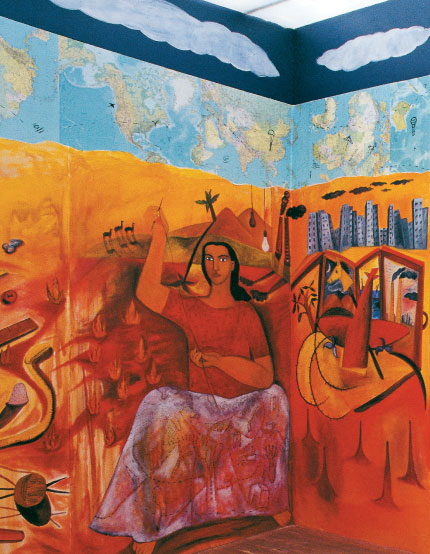
Songs from the Blood of the Weary was first created by artist Rekha Rodwittiya as part of an exhibition commemorating the 50th anniversary of the United Nations at Geneva in 1995. Curated by Adelina Von Furstenburg, the exhibition featured works by 60 artists from all over the world. Rodwittiya’s work was brought down to India once the exhibition ended and displayed at the Nehru Centre auditorium where Jehangir Nicholson came upon it and decided overnight that he wanted it to be part of his collection. Songs from the Blood of the Weary brings together twelve paintings in the form of a painted room that represent one of the earliest installations by an Indian artist.
Twelve additional works from the collection of Sakshi Gallery form part of this exhibition. They were all created in the years leading up to ‘the painted room’, the earliest work dating back to 1985 and provide us an understanding of the artist’s journey and the issues that are central to her work.
Rekha’s paintings seem to throb with the energy and vibrance that she brings to the whole process of living. Her canvases ooze varying shades of red, yellow and ochre sometimes almost painful in the suggestions they make or the events they allude to. Through her work she seeks a vocabulary that represents women without objectifying them. Her larger than life figures of women going about their daily tasks dominating their surroundings and the objects around them is a celebration of the female protagonist.
In the artist’s words - “My work celebrates all aspects of womanhood and explores the many avatars that female empowerment embraces. I hold as consistent the desire to examine the feminine space of survival, the spirit of female endurance and the empowerment of pride and self-dignity that centuries of feminist oral histories are infused by, as the territory from which my work takes shape. ”
The works from an earlier period included in this exhibition reflect Rodwittiya’s engagement with the socio-political environment that she finds herself within. Among these The Travellor Tells His-story is a seminal work that alludes to the bias of history favouring men. It marks a turning point in her practice, where Rodwittiya arrives at a language and style that come to represent her future work. Burnt Earth Yields Strange Fruit articulates her outrage at the increasing instances of honour killings, female infanticide and dowry deaths.

Rekha Rodwittiya was born in Bangalore in 1958. She studied painting at the Faculty of Fine Arts, Baroda in 1981 and at the Royal College of Art, London where she completed her Masters in Fine Arts in 1984 with an Inlaks Scholarship.
Rekha Rodwittiya’s work describes complex issues of life and living, of alienation and belonging, of discrimination and acceptance, of accord and discord. It is of paramount importance to this sensitive artist to react pragmatically to socio-political attitudes that surround her. Her work reflects her sensitivity towards socio-political attitudes along with the reflections from her past. Her images are a byproduct of her thoughts and emotions, her readings, observations, beliefs, values and vast compilation of past experiences.
Her politically feminist practice of painting came about while studying at the Faculty of Fine Arts, Baroda. She found herself at odds with the male chauvinism of her contemporaries, which did not allow for any gendered redefinition of art practice. This was a confirmation for her to seek a way of painting that functioned with clearly articulated feminist political intentions. Thus the representation of the female figure has been a huge concern for her.
The artist draws on a heritage of elemental imagery, tempered by psychological insights, portraying women through the prism of personal experience and day-to-day realities. In the early 1980s, the female figures in her work were often tortured and broken, strewn about in a hostile space, sometimes that of the convoluted, claustrophobic interior. Through the late 1980s and into the early 1990s, her paintings often had the appearance of a shadow play populated by their human and animal protagonists in compositions that aggressively pitched figures out of the picture plane, almost demanding participation from the audience. A narrative subtext with concealed references almost always underlies these works.
In Rodwittiya’s later works, she represents large clothed Gauginesque women as the archetypal figure in their daily work rituals, dwarfing their tools and objects that surround them, in a celebration of the female protagonist.
She has exhibited her works nationally and internationally. She has been actively involved in teaching art through alternative non-institutionalised methods, as well as being a guest faculty at art colleges all over the world. She is the founder and CEO of The Collective Studio, Baroda. She writes on gender politics, issues of identity, cultural methods and other subjects of concern within an Indian and globalised context of art practice. She is an independant curator and currently maintains a blogspace.
She lives and works in Baroda.